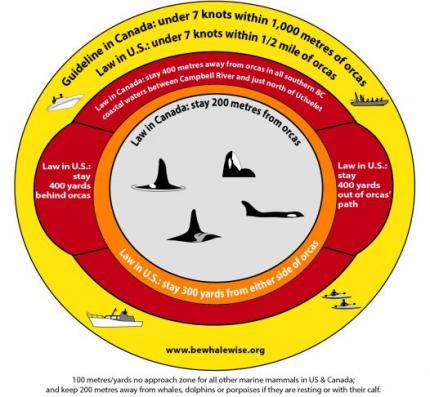ARCHIVED NEWS RELEASE
This document is provided for archival purposes only. Archived documents
do not reflect current WDFW regulations or policy and may contain factual
inaccuracies.
News release Feb. 22, 2021
Eryn Couch, 360-890-6604

OLYMPIA – With the recent observation of a new calf among the endangered Southern Resident killer whale (SRKW) population, the Washington Department of Fish and Wildlife, Northwest Marine Trade Association, Recreational Boating Association of Washington, Seattle Aquarium and The Whale Museum are calling for recreational boaters to steer clear of the whales and give them extra space on the water, supporting their survival.
“While this news of this calf gives us all hope for the future of these iconic animals, we need to continue to do everything we can to help give these special Southern Resident orcas the best chance at survival,” said Kelly Susewind, WDFW director. “This calf's mother, L86, needs to forage so she has plenty of nutrition she can pass on to the new baby.”
"We urge boaters in the area to Be Whale Wise this season and operate with extra caution in the Southern Resident killer whale habitat,” said Alanna Frayne, Be Whale Wise Coordinator at The Whale Museum in Friday Harbor. “With the exciting arrival of L125, in addition to the young calves in J Pod, it’s critical that this population is able to forage undisturbed."
Winter has been an increasingly important feeding time for Southern Resident killer whales. Their ability to catch prey during this time is critical to maintaining their health until Chinook salmon, their preferred food, becomes more plentiful later in the season.
“By giving the new calf and its extended family more space and quieter waters so they can find salmon, boaters can help give this little one the best chance of thriving in what continues to be a difficult time for the endangered orcas,” said Nora Nickum, ocean policy manager with the Seattle Aquarium.
Vessel traffic can interrupt echolocation clicks the whales use to track and capture fish. A key finding from research that National Oceanic and Atmospheric Administration (NOAA) Fisheries published earlier this year indicated this is especially prominent in females, which often give up foraging when boats approach within 400 yards. Research shows this may be most concerning in pregnant or nursing mothers that must support calves.
Further emphasizing the cause for concern, only about one-third of the SRKW population is actively breeding. Of those breeding, not many pregnancies result in live calves, and even when they do, not many calves survive.
The current SRKW population of 75 whales includes multiple pregnancies, with calves in both J and L pods. However, photogrammetry research by SR3 SeaLife Response Rehabilitation and Research indicates there are still whales of concerning condition in both pods.
“We’re delighted to hear of a new calf that adds to the Southern Resident killer whale population we all want to preserve,” said Bob Wise, president of the Recreational Boating Association of Washington Board. “We join the call for asking recreational boaters to follow the Be Whale Wise guidelines and regulations so that we can all play a positive role in ensuring the long-term survival of these awesome mammals.”
“This is great news, while I recognize we still have a ways to go,” said George Harris, NMTA president and CEO and Southern Resident Orca Task Force member. “If boaters continue to follow the Be Whale Wise guidelines and regulations we have supported from WDFW, we can play an important role in turning the tide on the survival of our Southern Resident killer whales.”
Regulations in place
With boating season right around the corner, officials ask boaters to know and abide by regulations and best practices that support the whales’ ability to move about, feed and socialize. Washington Gov. Jay Inslee signed new killer whale viewing regulations into law in 2019 that requires vessels to stay at least 300 yards from Southern Resident killer whales and at least 400 yards out of their path or behind the whales. Vessels must also reduce their speed to seven knots within a half-mile of a Southern Resident killer whale.
Boaters are encouraged to watch for the Whale Warning Flag, an optional tool from the San Juan County Marine Resources Committee, that lets others know that there might be whales nearby. If you see the flag, slow down and follow guidelines.
For more details about steps recreational boaters can take to keep the whales – and themselves – safe, visit BeWhaleWise.org.
Per newly adopted WDFW rules, motorized commercial whale watching boats are not permitted to approach within one-half mile of SRKW except for defined daily periods in July through September. Commercial whale watching vessels need to follow other Be Whale Wise guidelines for other orca ecotypes and marine mammals.
WDFW is the state agency tasked with preserving, protecting and perpetuating fish, wildlife and ecosystems, while providing sustainable fishing, hunting and other outdoor recreation opportunities.